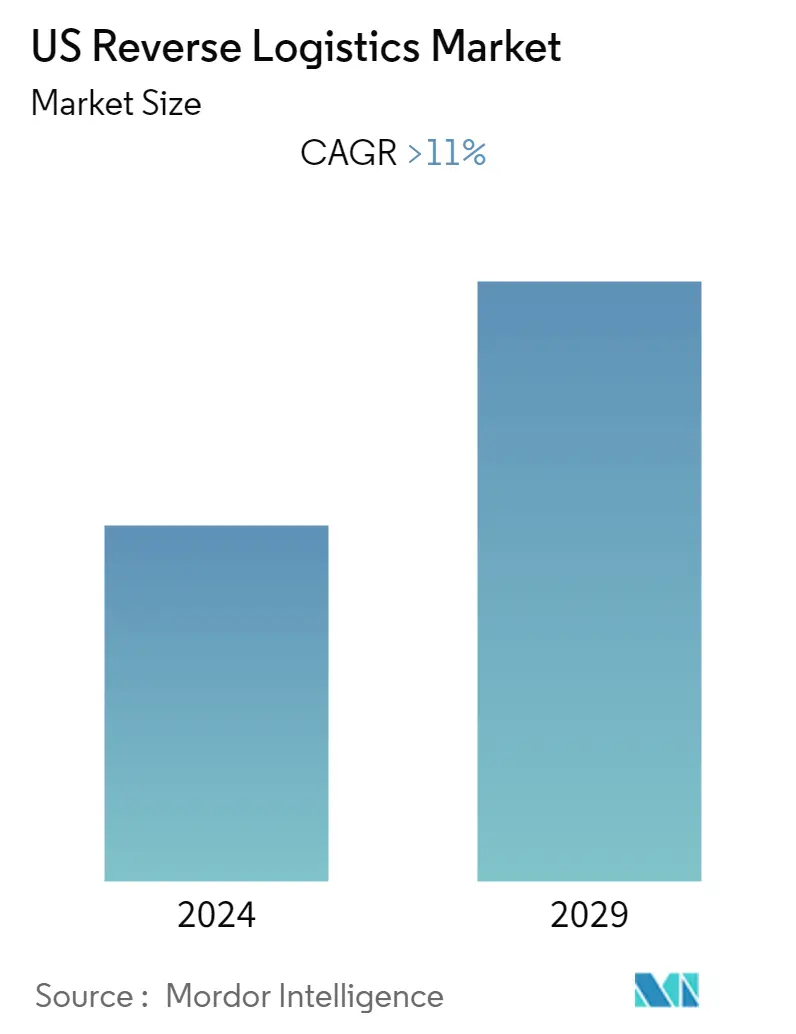Market Size of US Reverse Logistics Industry

| Study Period | 2020 - 2029 |
| Base Year For Estimation | 2023 |
| Forecast Data Period | 2024 - 2029 |
| Historical Data Period | 2020 - 2022 |
| CAGR | 11.00 % |
| Market Concentration | Low |
Major Players
*Disclaimer: Major Players sorted in no particular order |
US Reverse Logistics Market Analysis
- Online shopping and sales continue to grow at a rapid pace. As retailers and delivery companies move increasing numbers of outbound packages, they must also address the issue of rising volume of return goods. Around USD 120 billion of e-commerce purchases were returned in 2017. Online purchased goods are three times more likely to be returned than those made in a general physical store. Though returns pose challenges for retailers, they find it challenging to limit returns because customers increasingly see returns as a critical part of online shopping experience. The reputation for fast, free, and friendly returns can earn customer loyalty, while a poor return experience can easily drive them away. With GBP 5 billion worth of returns ending up in landfills, apart from the waste from packaging, retailers are also struggling to make their reverse supply chains highly sustainable. To control the associated costs and improve customer experience, retailers are trying several strategies. Retailers with an existing physical presence have started embracing omnichannel returns, allowing returns of online purchases at existing physical stores. Emerging technologies, such as automated parcel lockers, and smartphone apps, are creating a more seamless return experience. However, retailers still see returns as a significant challenge to be overcome, and as a cost center, which has created opportunities for innovation for all players in the reverse logistics industry.
- Reverse logistics is more complicated than forward logistics. Retailers want shipping companies that create new efficiencies and cut costs. According to an industry survey, 60% of active online shoppers say that free returns are a vital part of a good returns experience.
- The US auto industry recorded the sales of 17.3 million vehicles in 2018, beating the industry expectations. Reverse logistics cost in the US auto and auto components industry is significant.
- Additionally, companies are looking to outsource non-traditional logistics requirements, such as reverse logistics, order processing, inventory management, distribution, and labeling and packaging. This is expected to provide more opportunities for logistics service providers (LSPs).
US Reverse Logistics Industry Segmentation
A complete background analysis of the US reverse logistics market, including an assessment of the economy and contribution of the logistics sector in the economy, along with market overview and market size estimation for the key segments, and emerging trends in the market segments. The report also covers an analysis on the market dynamics and key insights of the market.
| By Function | |||||
| |||||
| Warehousing (Storage, Distribution, and Consolidation) | |||||
| Other Value-added Services (Return Processing, Restocking, Refurbishment, Disposition, etc.) |
| By End User | |
| Consumer and Retail (Covers E-commerce, Consumer Electronics, Apparel and Garment Sectors, etc.) | |
| Automotive | |
| Healthcare and Pharmaceuticals | |
| Other Industrial Activity Sectors | |
| Other End Users |
US Reverse Logistics Market Size Summary
The US reverse logistics market is experiencing significant growth, driven by the rapid expansion of e-commerce and the increasing volume of returned goods. As online shopping continues to rise, retailers face the challenge of managing returns efficiently while maintaining customer satisfaction. The complexity of reverse logistics, compared to forward logistics, necessitates innovative solutions to streamline processes and reduce costs. Retailers are adopting strategies such as omnichannel returns and leveraging emerging technologies like automated parcel lockers and smartphone apps to enhance the return experience. Despite these efforts, returns remain a cost center, presenting opportunities for logistics service providers to offer specialized solutions that improve efficiency and sustainability in reverse supply chains.
The competitive landscape of the US reverse logistics market is evolving, with logistics firms and third-party providers playing a crucial role in addressing the challenges posed by returns. Companies are increasingly outsourcing non-traditional logistics functions, including reverse logistics, to capitalize on the expertise and scale of logistics service providers. Technology is also transforming the reverse supply chain, with software solutions like Optoro optimizing the disposition of returned items to maximize profitability. The trend towards omnichannel returns, where consumers can return online purchases at physical locations, is gaining traction, offering benefits such as cost savings and increased customer engagement. As the market becomes more competitive, businesses that focus on efficient returns management are likely to gain a competitive edge, enhancing customer experience and profitability.
US Reverse Logistics Market Size - Table of Contents
-
1. MARKET INSIGHTS
-
1.1 Current Market Scenario
-
1.2 Technological Trends and Automation (In-depth Focus on Emerging Startups)
-
1.3 Study on Changing Consumer Behavior and Their Preferences
-
1.4 Spotlight - US E-commerce Industry (Current Scenario, Trends, and Outlook)
-
1.5 Impact of Cost of Returns on Retailers - Analyst's View
-
1.6 Brief on Automotive Reverse Logistics and Aftermarket
-
1.7 Review and Commentary on Emerging Omnichannel Returns
-
1.8 Insights on Closed-loop Supply Chain
-
-
2. MARKET SEGMENTATION
-
2.1 By Function
-
2.1.1 Transportation
-
2.1.1.1 Road
-
2.1.1.2 Air
-
2.1.1.3 Other Modes of Transportation
-
-
2.1.2 Warehousing (Storage, Distribution, and Consolidation)
-
2.1.3 Other Value-added Services (Return Processing, Restocking, Refurbishment, Disposition, etc.)
-
-
2.2 By End User
-
2.2.1 Consumer and Retail (Covers E-commerce, Consumer Electronics, Apparel and Garment Sectors, etc.)
-
2.2.2 Automotive
-
2.2.3 Healthcare and Pharmaceuticals
-
2.2.4 Other Industrial Activity Sectors
-
2.2.5 Other End Users
-
-
US Reverse Logistics Market Size FAQs
What is the current US Reverse Logistics Market size?
The US Reverse Logistics Market is projected to register a CAGR of greater than 11% during the forecast period (2024-2029)
Who are the key players in US Reverse Logistics Market?
United Parcel Service, FedEx Corporation, United States Postal Service, Newgistics and XPO Logistics are the major companies operating in the US Reverse Logistics Market.

